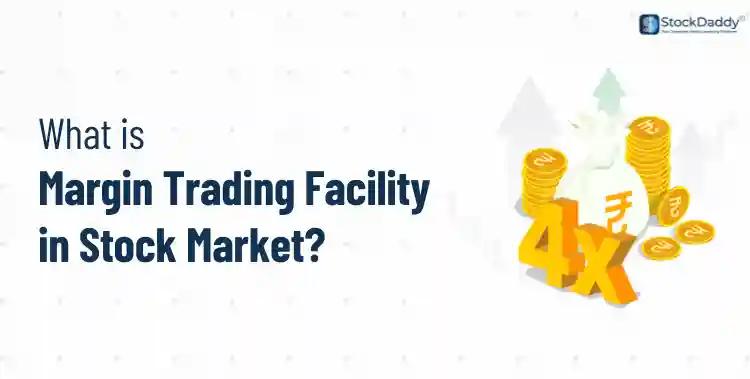Blog >
What is Margin Trading Facility
What is Margin Trading Facility

Margin Trading Facility is a leveraging facility offered by the stockbrokers to traders by which they can buy stocks at credit by paying only a fraction of the total amount and the rest is funded by the stockbroker. This facility is also known as Buy Now Pay Later or E-Margin facility that boosts your purchasing power and allows you to buy more stocks even if you have insufficient funds.
Traders who have conviction about the future movement of stocks but lack sufficient funds can use this facility. In return, the broker charges interest generally on a daily basis on the total amount of credit given, which could vary across different brokers.
Framework of Marginal Trading Facility
Margin trading is formalized with an agreement between the trader and the stockbroker. The agreement comprises of the margin rate and extent of margin. The margin rate as we know is the rate at which a stockbroker lends to the trader in addition to a markup which depends on the extent of risk in the margin account. Interest rate or margin is usually levied on a daily basis, although it also depends on the brokers.
The agreement comprises of two types of margins: initial margin and maintenance margin. The initial margin is the percentage of the total purchase value which a trader has to pay to the lender before the actual purchase takes place.
Once the initial margin is paid, the lender opens a margin account and pays the remaining margin debt to carry out the order. The purchased stocks are pledged against the margin debt provided by the lender as per the SEBI guidelines.
Apart from the initial deposit, the trader also has to maintain a maintenance limit or minimum equity in the margin account. It is the net value of the portfolio i.e. value of the portfolio minus the debt margin.
Let's understand it with an example. Suppose the initial deposit is 20% of the total portfolio value and the minimum maintenance limit is 25%. Now if the portfolio value is Rs.100 so the trader will pay Rs.20 as an initial deposit and the broker will leverage the remaining Rs.80. Now the value of the portfolio has been reduced to 90. The net value of the portfolio is Rs.100 - Rs.80 = Rs.20 and the minimum maintenance limit is 25% of 90 i.e. Rs.22.5. But the minimum equity remaining here is Rs.90- Rs.80= Rs.10.
Hence to cover the shortfall the trader will have to deposit Rs.12.5 in the margin account and the broker gives a margin call for the same. Generally, in case of reduction in stock prices post margin trading if the share price reaches the same level as margin debt, the broker can automatically square off the position to cover their debt without even giving the margin call.
Key Elements of Margin Trading Facility
Here are the important elements of Margin Trading Facility that you should know to understand how it works:
1). Minimum Margin Requirement
To use the margin trading facility traders are required to maintain a minimum level of equity in the portfolio predetermined in the agreement. (generally, 20% of the total trading amount).
2). Initial Margin
Traders/Investors are required to pay a portion of the total value of the purchase as an initial deposit after which a margin account is made and trade is carried out by the intermediary.
3). Leverage/ Margin debt
This is the main element of MTF, where you pay only the minimum margin requirement, and the broker leverages your trade by funding the remaining amount.
4). Margin rate
As they say there are no free lunches, it is the same case here as the broker charges interest on the amount funded irrespective of the results of your trade. The interest rates of MTF vary from broker to broker while most charge it on a daily basis which makes MTF more suited for Intraday traders.
5). Share Pledging
You are required to pledge the shares you are buying using the Margin Trading Facility against the margin debt. The broker provides margin funding based on the value of the pledged stocks. Once the trader pays back the margin amount plus interest his shares are unpledged.
6). Carry-forward
In margin trading you can hold your positions bought from margin up to T+N days. Here T is the day on which the trade was initiated, and N is the days for which you can carry forward the trade. The number of days for which you can carry forward the position varies across different stockbrokers.
7). Margin Call
A margin call occurs when the equity balance is lower than the maintenance margin level set by the broker. In such instances, brokers can ask traders to add more funds to maintain the minimum margin level.
Generally, such a situation occurs in the case of a losing trade. In case the trader is unable to deposit the funds then the broker has the right to sell off the trade at market price to square off the position.
SEBI regulations on margin trading
It is SEBI’s utmost priority to safeguard the interests of traders and investors in the stock market which is why they have certain rules and regulations in place for almost everything. Here are the regulations SEBI has laid down regarding margin trading in stock market:
1). Initial Deposit Requirement
SEBI has made it mandatory for traders to pay an initial deposit of at least 20% of the total portfolio value on T Day. Additionally, the trader is also required to pay additional margin on T+N days as minimum maintenance requirement if required.
2). Initial margin at time of selling shares
According to SEBI guidelines, traders are also required to pay an initial margin of minimum 20% at the time of selling the shares too. Intermediaries will do early pay-in to avoid initial margin.
3). Short margin penalty
The trader is liable for penalty in case he fails to maintain the minimum level of margin requirement.
4). Collateral
The shares bought through margin trading will be placed in the trader’s demat account. Also, the limitations on the trade of shares will be limited to those shares only which are pledged through the shares pledge mechanism.
Risks Associated with Margin Trading for Traders/Investors
Margin trading comes with its own set of risks for those availing this facility which should be considered. Here are the key risks which you should keep in mind:
The trader or investor availing the margin trading facility will incur magnified losses if his bets backfire.
In case of reduction in portfolio because of market dynamics the investor is required to bring in more funds to maintain the margin maintenance levels and forced sale of securities purchase via margin funding.
In case of a fall in the value of a portfolio, the lender will make a margin call to deposit additional funds to maintain the minimum margin level. In case of non-compliance, the lender has the right to sell the pledged shares at the current market price.
Conclusion
Margin trading is a useful facility for those who want to trade stocks but don't have sufficient funds. They can leverage their purchasing prowess through borrowed funds and have to pay charges for the borrowed funds. However, before availing this facility, people should consider their interest and their risk-taking capacity as the losses could increase significantly in case of their positions going wrong.

- Recent Blogs
- What is gold Bees ETF and How to invest in it?
- Difference Between Call and Put Option
- Types of Charts in Stock Market
- what is CPSE etf and How is it a good investment Opportunity
- What is Margin Trading Facility
- why Tata Motors Share is Falling?
- Disadvantages of SIP Investment You Should Know
- Can Stock Market make you Rich?
- Difference Between Sensex and Nifty
- Difference Between Fundamental Analysis and Technical Analysis